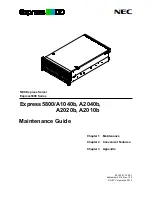
49
Chapter 4: Storage
Virtualizing Storage within your Network
Network Storage System (NSS) Administrator Guide
Chapter
4
Virtualizing Storage within your Network
The NSS virtualization feature lets you create storage physically located on other network NSS units
into one logical storage unit. The recommended network configuration for using virtualization is to
use an NSS6000 series to operate as the "master" storage device (the "slave" devices can either be
NSS6000 series or NSS4000 series devices). This configuration setup means that you export
storage (must be an unused disk drive or configured array) from the slave NSS and then import the
storage into the master NSS. The supported RAID level for virtualized storage is JBOD (although the
JBOD can consist of concatenated exported arrays).
Currently Exported Storage
The
Currently Exported Storage
table shows the details for any exported disks or arrays:
•
Device:
The name of the exported disk or array.
•
Size:
The size of the exported storage.
•
Imported by:
The serial number of the NSS that has imported the storage. If the exported disk
or array has not yet been imported by the master NSS, "None" appears in this column.
•
Action:
Click the
Unexport
button to stop the NSS from exporting the associated drive or
array. This frees up the drive or array for use in local RAID arrays.
Currently Imported Storage
For the master NSS to access a disk from another NSS on the network, the network device that
contains the storage must first export its storage. Once the exported storage is involved in an array
on the master device it appears in the
Currently Imported Storage
table. Until the exported storage
is used to build a JBOD, the storage appears in the list of available disks in the
New RAID Device
table on the
RAID
page.
•
Device:
The name of the imported disk or array.
•
Size:
The size of the imported disk or array.
•
Exported by:
The serial number of the network device that exported the storage to the
network.
















































